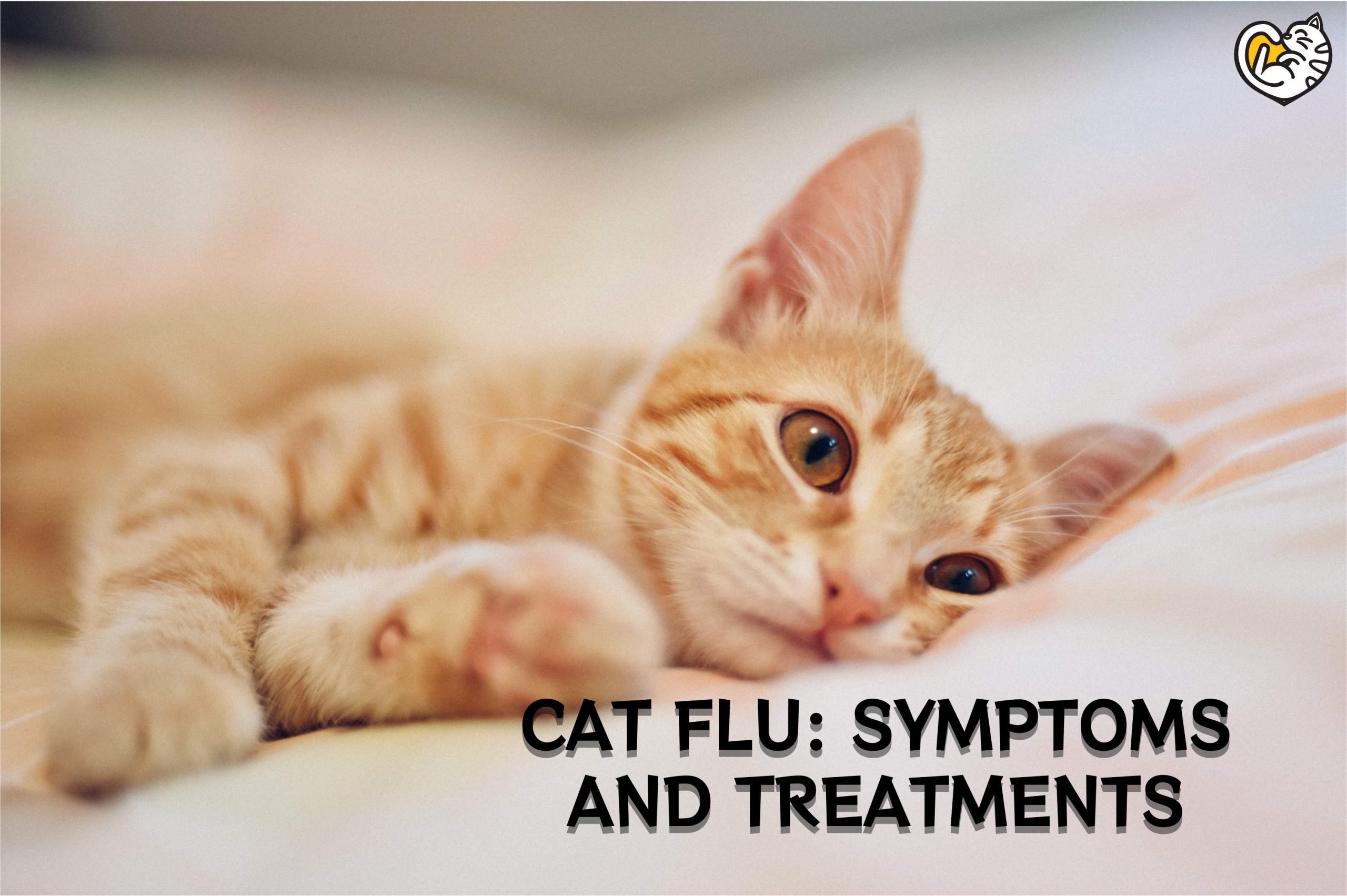Cat Flu: Symptoms and Treatments

Just like humans, cats are prone to the flu. They can suffer from cat flu which is a very common and contagious condition. Like its human equivalent, cat flu symptoms include breathing problems, coughing, runny nose and eyes.
As a cat lover, you only want the best for your feline pals. So, in this article, we will look at the cat flu symptoms and treatments, including everything you need to know about the condition and some of the frequently asked questions about cat flu.
Want your cat to live the longest, healthiest, and happiest life?
It starts with what’s in their bowl.
Every meal is a chance to give your cat more energy, fewer vet visits, a shinier coat, and a longer, happier life by your side.
Choose food that truly understands your cat’s needs.
Choose Grace Cat. 🐾
Malaysia’s First Freeze-Dried Complete Meal With Krill Oil & Postbiotic
What Is Cat Flu?
Cat flu is a term used to describe upper respiratory tract infection caused by feline viruses and bacteria infections. These infections mainly affect the nose and the throat. It can affect cats of all ages and breeds, with kittens, purebred and unvaccinated cats being the most vulnerable.
Causes of Cat Flu
Cat flu is caused by two common viruses, the Feline Calicivirus (FCV) or the Feline Herpes Virus (FHV). Fortunately, these are not the same virus that causes human flu. You can’t catch it from your cats, but it can be transmitted from one cat to another.
These viruses are transmitted when an infected cat sneezes or coughs and your cat inhales contaminated air droplets, and when your cat comes in contact with any objects that have the contaminated cat’s saliva. Other causes include the bacteria Chlamydophila felis and Bordetella, which can have a high mortality rate in cats.
Humans could unintentionally spread cat flu because the virus can survive on surfaces for hours if it remains wet. Unknowingly, you can take it home in your shoes or clothes. Infected cats can be severely affected. Therefore, it is important for all cats to be vaccinated against the viruses that cause cat flu.
Many cats infected with the FHV become chronic carriers; this means they can transmit the virus even after they are no longer sick, particularly when they are stressed. When stressed, the cat can secrete the virus for up to two weeks.
Cat Flu Symptoms
The common symptoms of cat flu include:
Sneezing
Just like humans, cats sneeze because something has irritated the inside of its nose. Sneezing occasionally is not a problem, but if your cat is frequently sneezing or has severe stints of sneezing, you should contact your vet. This is because sneezing is one of the symptoms of cat flu. Therefore, you need to get your vet for an urgent appointment if your cat can’t stop sneezing, sneezes blood, or look as if it is in pain.
Discharge From the Nose and Eyes
Tearful nose and eyes indicate that something is wrong. It is normal to have a small amount of crusting in the corner of your cat’s eyes, but it is not normal to have a constant sticky discharge in your cat’s eyes. Don’t ignore tearful eyes and nose; these may be a symptom of cat flu. Always contact your veterinarian as soon as you notice a change in your cat’s eyes or nose. The problem could get worse if not treated fast.
Lethargy
Lethargy or lack of energy is another symptom of cat flu, although it can be a result of many different problems, some are minor and some are more serious. The lethargy may be so serious that the cat refuses to move or even to use the litter box.
Cats conserve energy for hunting, which means that they habitually sleep 12 to 16 hours daily. Consult your veterinarian if your cats sleep more than usual, look calmer than usual or show lesser interest in food, hunting, playing and going outside.
Lack of Appetite
This can result from many different conditions, but it is one of the common signs of cat flu. It can be very alarming if your cat stops eating. Without food, they are at risk of developing a fatty liver disease known as lipidosis. For this reason, always have your cat checked by your vet if its appetite changes.
Fever
Fever is a symptom of cat flu, although fever can be caused by various issues ranging from trivial to life-threatening. Cats have an average body temperature of 37.2 degrees to 39.2 degrees Celsius. Fever can occur if temperatures exceed 39.2 degrees Celsius. If your cat has a high fever, refuse to eat, shiver and breathe faster than usual, contact your veterinarian for immediate attention.
Diagnosis of Cat Flu
Diagnosis is generally based on the cat’s physical examination and clinical signs. Based on your cat’s symptoms, the veterinarian should be able to provide you with a temporary diagnosis. If your cat has the above symptoms, particularly if many cats have become ill in the same household, your vet will suspect cat flu. If the symptoms persist, more examination will be required to determine the underlying cause.
The vet will need blood samples, including swabs from the cat’s nose and mouth, to send to the laboratory for testing in order to get a perfect diagnosis. With this, it is possible to isolate and identify the causing virus or bacteria. Diagnosis can be complicated when your cat has more than one infection or only the FHV because it is only shedding from time to time.
Treatments for Cat Flu
Treatments for cat flu varies according to the cause. Most of the time, treatment is usually symptomatic alleviation, which involves keeping the cat nose and eyes clean and clear. Antibiotics are also being used to treat secondary bacterial infections. Mucolytics are also administered to ease the thickness of secretions and make it easier for the cats to breathe. It is likely for dehydration to occur as the condition worsens, thus eating and drinking should be encouraged. Hospitalisation, constant monitoring and intravenous fluids may be necessary for seriously sick cats.
Home Remedy for Treating Cat Flu
For now, there is no cure for cat flu, but there are a few things you can do to speed up the recovery time. Things you can do at home once you have seen the vet help your cat feel better and recover as quickly as possible. The following are some of the home remedies for treating cat flu:
- You can use vet-approved lubricating eye drops to keep your cat eyes moist as they heal.
- Your cat’s sense of smell can be affected by the infection, and a sore throat can make feeding difficult. Add a tiny amount of strong-smelling food e.g. tuna or freeze-dried pet food, to your cat’s regular meals to entice it to eat.
- You can also warm the food because warm food has a stronger aroma. Mix warmed food carefully and make sure it is not too hot.
- Wipe any dirt from your cat’s eyes and nose with a cotton wool pad soaked in warm water. This will remove any discharges and make your cat feel better, allowing him to breathe more easily and smell his food better, this keeps its appetite alive.
- Make your cat’s life as stress-free as possible. Stress weakens their natural defences against disease and raises the likelihood of the flu outbreak to be longer.
- Maintain a warm, dry and pleasant environment for your sick cat. If you have other cats in the house that are not infected, provide a safe place for your sick cat to recover. Make it comfortable by placing its litter box and bed close by, as well as plenty of fresh food and water.
How to Prevent Cat Flu
Cat flu vaccination is an effective way to prevent the disease in many households. Although vaccination may not 100% prevent your cat from being infected, it will significantly minimise the severity of the disease. Even cats that have been infected with the disease should be vaccinated because most likely, they have been infected by one of the viruses and are still prone to be infected by other strains.
Vaccination alone may not be enough to keep the disease at bay in multi-cat households and boarding facilities. Sterilisation is crucial. Carrier or sick cats should be isolated, with their bowls and litter trays frequently cleaned.
Avoid stress because it can trigger a flare-up. There are a few things you can do to reduce stress. Make sure you provide enough hiding spots for your cat. Ensure that the infected cat’s litter box, eating bowl and water bowls are not accessible by other cats. Also, you can make use of pheromone therapy such as a Zenifel diffuser.
Frequently Asked Questions About Cat Flu
How long does cat flu last?
In most cases, cat flu can last between 10 days to three weeks after being exposed to the virus. The cat may become ill within two to five days. Cats infected with the FHV usually show symptoms for five to ten days in mild cases and about six weeks in severe cases. The cats may develop long-term health problems and are more vulnerable to subsequent bacterial infections. It is important to note that cats infected with FHV are infected for life.
My cat is sneezing, is it cat flu?
Anything that irritates your cat’s nose can cause sneezing, things like air freshener, cigarette smoke, or allergies. If the sneezing does not come with other cat flu symptoms like nose and eyes discharge, these irritants may be the cause. It is always advisable to see your veterinarian if you are not sure about the cause.
Does cat flu go away by itself?
In many instances, cat flu is usually harmless and will disappear within one to two weeks. You should keep an eye on your cat’s health, but if there is no improvement by the fourth day, you should contact your veterinarian, as persistent flu that is not treated correctly can lead to pneumonia, eye damage or even death.
Can cat flu spread to another cat?
Cat flu can be easily spread to other cats by coming into contact with infected toys, feeders or on people’s clothing after coming in contact with an infected cat. The virus is transmitted through nose/eye secretions and saliva from an infected cat. The virus can also live in the environment and spread to other cats.
Can cat flu spread to dogs?
The good news is that your dog cannot catch cat flu. Cats and dogs are known to spread diseases like ringworm to one another, but no study has shown that dogs can get the flu from cats when it comes to cat flu. Nevertheless, if you have a dog and a cat, and one is sick, it is still good to keep them apart for a better recovery environment.
When to take my cat to a vet?
You should always take your cat to the vet if you suspect your cat is in danger in any way. If you notice flu symptoms, such as your cat stopped eating, being tired or having trouble breathing, and the symptoms don’t improve right away, it is time to contact your vet for an appointment. It is crucial to have your cats check fast because the condition can quickly deteriorate.
Is there a cat flu vaccine?
Of course, there is a shot that protects against the cat flu virus. Our recommendation is to vaccinate your cats against the disease as soon as possible. This is the most effective approach to minimize the danger of spreading cat flu. Kittens as young as eight weeks old can be vaccinated.
It is important to remember that cat flu vaccines are not always 100% effective, and even vaccinated cats can become carriers without showing any symptoms.
Lastly, you can help relieve your cat’s pain and suffering during the disease by responding quickly after identifying the cat flu symptoms. Consult your veterinarian for further assistance if you observe any of the symptoms. The best way to prevent your feline pal against cat flu is to stay up with its vaccines and be aware of the flu signs. If your cat does catch flu, don’t worry. Your cat will feel better in no time with a little more love and attention from you.
Still feeding low-quality pet lick treat to your pets?
You could be giving them a time bomb in disguise — one that slowly harms their health, weakens their immunity, and makes them sick.
It’s time to switch to safer, healthier options — before it’s too late.
Try out our gloow Nutrition Pet Lick – The first Algal Oil & Postbiotic Pet Lick in Malaysia









